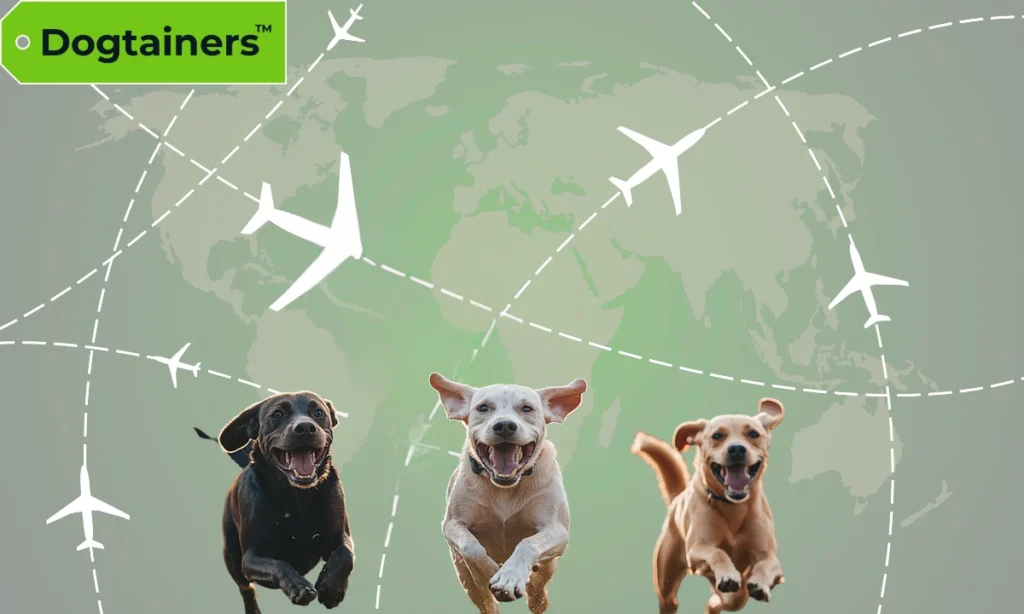Travelling internationally with your pet is a complex undertaking. International pet travel requires thorough planning, documentation and knowledge of country regulations.
The rabies vaccine for dogs and cats is one of the most important considerations.
Rabies vaccination is a requirement for pets entering many countries. And it’s crucial for ensuring your pet’s health and safety against rabies.
This vaccine protects your beloved pets from one of the most dangerous viral diseases known to affect mammals.
Also, the vaccine protects pets and native animals in the import country.
For instance, Australia has strict controls in place for pets entering the country. Your pet needs the rabies vaccine when travelling to Australia from most countries.
Let’s discover why your pet needs the rabies shot before international travel.
Why Does My Pet Need the Rabies Vaccine Before International Travel?
Before travelling with pets internationally, pets need a rabies vaccination to meet the legal entry requirements of most countries. These laws are designed to prevent the spread of rabies.
Ensuring all entering animals are vaccinated against rabies protects local animal populations and public health.
Specific requirements can vary. For example, the UK mandates that pets must be vaccinated against rabies before they can travel and that the vaccination must be administered at least 21 days before arrival. Similarly, dogs entering the United States must have a valid rabies vaccination certificate in certain circumstances.
Protecting Your Pet’s Health
The rabies vaccine is crucial for protecting your pet’s health. Getting them vaccinated before international travel prevents them from contracting rabies, especially in regions where the disease is prevalent.
Rabies is a deadly virus that affects the brain and spinal cord of mammals, including dogs and cats. The disease is 99% fatal and 100% preventable.
The rabies vaccine for dogs and cats prepares your pet’s immune system to fight the virus. Strong immunity stops the disease from developing even if they are exposed.
International Travel Compliance
Do you plan on travelling internationally with your furry companion? Pet travel standards include getting all necessary vaccinations the destination country requires.
Compliance is critical for the smooth travel of your pet to the destination country. But you also need to consider re-entry into your home country without complications.
Say you’re relocating with your pet from Australia to another country for a few years. You must ensure that your pet meets the entry requirements to Australia when you’re returning.
That most likely includes the rabies vaccination for your dog or cat, depending on the export country.
Rabies Vaccination Schedule for Cats and Dogs Leaving Australia
Australia is a rabies-free country. The rabies shot isn’t on the regular pet vaccination schedule for dogs and cats.
That’s if your pet remains in Australia. But some countries require your pet to get a rabies immunisation before entry.
Rabies Vaccination Schedule
An approved vet must administer the rabies vaccine to your pet. The schedule depends on the importing country.
For instance, the European Union (EU) requires a 21-day wait period between the rabies vaccination and the day of export.
Certified Veterinarians
In Australia, rabies vaccinations must be administered by certified veterinarians. The vaccines aren’t certified for general use and are only available to order by registered vets.
This ensures the vaccine is administered correctly and is officially recognised by the destination country.
The vet should:
- Scan your pet’s microchip and ensure the ID number matches the rabies vaccination certificate and other documentation
- Check your pet’s age and confirm it’s old enough to get the rabies vaccine
According to the DAFF, your pet must be 3 calendar months old, which is different to 12 weeks of age, to receive the rabies shot.
Pet Travel Companies
Experienced pet travel companies like Dogtainers can help you navigate rabies vaccination before international travel. There are a lot of different considerations for international pet travel, with the rabies vaccination only being one.
We’re fully up to date with each country’s regulations surrounding rabies shots. Our experts understand that travelling with pets can be stressful – professional knowledge can help relieve your anxiety.
We have relationships with approved vets with experience administering rabies vaccinations for international pet travel. You don’t need to organise everything alone.
Dogtainers also has expert knowledge of bringing pets into Australia. So if you’ll be returning again to Australia later, we can help you navigate the re-entry process for your pet.
What is Rabies?
Definition and Causes
Rabies is a zoonotic (passed from animals to humans) viral disease that primarily affects the central nervous system. Infection leads to severe neurological symptoms and, without treatment, death.
The virus is typically transmitted from infected animals via bites, scratches, or contact with mucous membranes.
According to the World Health Organisation, domestic dogs are the most common transmitters of rabies to humans, responsible for the vast majority of cases worldwide.
Global Distribution
Rabies is prevalent in over 150 countries, with the highest burden in Asia and Africa. The disease causes tens of thousands of deaths annually, particularly affecting children under 15 years old.
Rabies is also present in parts of the Americas. Efforts to eliminate the disease through vaccination of dogs have been successful in reducing its incidence. And the U.S. has eliminated rabies in dogs.
Australia is a rabies-free country. That’s why we have strict regulations in place when bringing pets into Australia.
Impact on Health
Rabies is almost always fatal once symptoms appear, making timely medical intervention crucial. Early symptoms include fever, pain and tingling at the site of exposure.
Without fast treatment, the symptoms progress to severe neurological reactions such as aggression, hallucinations, paralysis, and ultimately death.
Rabies is particularly dangerous because it passes from animals to humans. So you and your pets are at risk.
Vaccination against rabies remains the most effective method for controlling and potentially eliminating this deadly disease.
How the Rabies Vaccine Works
Vaccine Mechanism
The rabies vaccine activates the immune response by introducing an inactivated or attenuated form of the rabies virus. The vaccination stimulates the immune system to produce antibodies.
These antibodies can recognise and fight the rabies virus. Immunisation prepares your pet’s body to combat the virus effectively if exposed in the future.
Duration of Immunity
The immunity provided by the rabies vaccine for cats and dogs lasts around three years. Your pet should get a rabies booster shot about every three years if required.
The Rabies Antibody Titre Test
Purpose of the Test
The rabies titre test measures the rabies antibody level in your pet’s blood. The test confirms an acceptable immune response to the rabies vaccine in your pet.
The rabies titre test offers proof of protection against rabies virus infection for your pet.
Generally, pets entering Australia require the rabies titre test. Other countries require the test when you’re travelling internationally with your pets.
Passing the test ensures your pet poses a low risk of introducing rabies into the destination country.
Rabies in Pets FAQ
How Do Dogs and Cats Get Rabies?
Rabies is primarily transmitted to dogs and cats through the bite of an infected animal. The rabies virus is present in high levels in the saliva of infected animals and enters the body through breaks in the skin, usually from a bite.
Non-bite exposures can also transmit rabies. These are less common and involve the contamination of open wounds, abrasions or mucous membranes.
Several situations significantly increase the risk of rabies transmission to dogs and cats:
- Encounters with wildlife: Pets may encounter wild animals that are common carriers of rabies – raccoons, skunks, bats and foxes. These interactions are particularly risky if they occur in areas where rabies is endemic.
- Fights among animals: Dogs and cats that are allowed to roam freely are more likely to engage in fights with other animals. This increases their risk of being bitten by an infected animal.
- Travel to high-risk areas: Travelling to regions where rabies is common in the wildlife population presents a higher risk for pets.
- Lack of vaccination: Unvaccinated pets are at a higher risk of contracting rabies if they are exposed to the virus. Vaccination is the most effective way to prevent rabies in dogs and cats and is required by law in many areas.
What Are the Rabies Symptoms in Cats and Dogs?
The early signs of rabies in pets can vary but often begin subtly. In cats and dogs, early symptoms can include behavioural changes like:
- Increased excitability
- Aggression
- Confusion
- Excessive licking at the bite site
Dogs may exhibit more vocal behaviour like howling or yelping, while cats might hide more or act unusually aggressively.
As rabies progresses in cats and dogs, the symptoms become more severe and distinct. The virus affects the central nervous system.
Progressive infection leads to more pronounced signs such as:
- Paralysis
- Seizures
- Hydrophobia (Fear or aversion to water)
Drooling and foaming at the mouth occur due to the inability to swallow. Muscle control deteriorates, eventually leading to death if untreated.
The progression from initial symptoms to more severe stages can happen rapidly, often within days. Rabies is extremely severe and early detection and preventive vaccination to manage this fatal disease effectively is crucial.
Are there rabies vaccine side effects?
The rabies vaccine is generally safe for pets. But like any vaccine, it can cause some side effects.
The most common side effects in pets include mild reactions such as soreness at the injection site, temporary fever, lethargy, and loss of appetite. These symptoms are typically short-lived, resolving within a few days.
Severe side effects are very rare. Few reported cases include anaphylaxis, a serious and potentially life-threatening allergic reaction that can develop rapidly after the vaccine is administered. Symptoms of anaphylaxis may include difficulty breathing, facial swelling, hives, and collapse.
Another rare but serious condition is Vaccine-Associated Sarcoma (VAS), a type of cancer that can develop at the site of the injection. This is more commonly associated with cats but can occur in dogs.
Conclusion
Vaccinating your pet against rabies is a critical step in preparing for international pet travel. Most countries require the rabies vaccine for dogs and cats before entry.
The rabies shot plays a crucial role in maintaining public and animal health. Countries like Australia are rabies-free and mandating the rabies vaccine for pets keeps that status safe.
Rabies vaccinations prevent your pet from contracting the virus, particularly in regions where the disease is prevalent. Your pet may also need the rabies antibody titre test to prove they are immunised against rabies before travel.
We recommend planning at least six months in advance for international pet travel. Travelling with pets is complex, with many different rules and regulations to follow.
These include:
- Pet eligibility
- Microchipping
- Identity verification
- Import permits
- Vaccinations
- And more
A pet transport company like Dogtainers can help you navigate the complexity of international pet travel.
We’ve spent 50+ years safely transporting pets around the world. You can leave the pet travel to us while you focus on everything else.
Simply get a quote to start your international pet travel journey.





Share this article